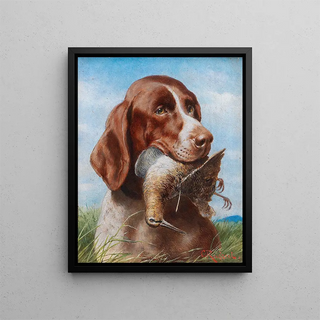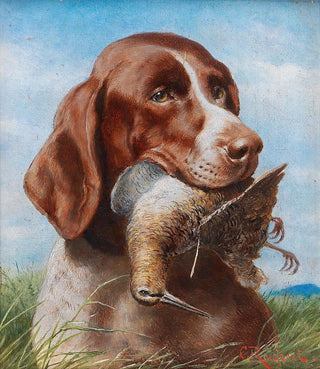Art print | Hunting dog with woodcock - Carl Reichert Source: Reproduction | Chien de chasse avec bécassine - Carl Reichert


View from behind

Frame (optional)
In the world of art, some works manage to capture the very essence of nature and the human soul. The art print Chien de chasse avec bécassine - Carl Reichert is a perfect example. This painting, created by the Austrian painter Carl Reichert, immerses us in a universe where the beauty of wildlife blends with the finesse of the human gaze. Through this piece, the viewer is invited to explore a suspended moment in time, where the noble and attentive hunting dog is ready to spring into action, while the delicate and elusive snipe remains both present and distant. This artwork evokes harmony between man and nature, a timeless theme that resonates deeply in our relationship with the environment.
Style and uniqueness of the work
Carl Reichert's style is distinguished by his ability to combine realism and sensitivity. In Chien de chasse avec bécassine, every detail is carefully observed and rendered with remarkable precision. The textures of the dog's coat, the color nuances of the snipe, and the elements of the surrounding landscape are treated with such meticulousness that they seem almost tangible. The artist manages to breathe life into his subjects, capturing not only their appearance but also their essence. The light, playing on shapes and shadows, creates an atmosphere that is both serene and dynamic, inviting the viewer to lose themselves in this bucolic scene. This piece, while a tribute to hunting, also serves as a celebration of the beauty of nature—a delicate balance between the wild and the domestic.
The artist and his influence
Carl Reichert, born in 1836 in Vienna, is recognized for his mastery of animal painting. His artistic journey is marked by a fascination with wildlife, which he has translated with unique sensitivity. Influenced by the great masters of realism, Reichert developed his own style, combining technical precision with emotion. His works, often imbued with a certain romanticism, testify to a deep respect for nature and animals. By choosing to depict hunting scenes, he does not

Matte finish

View from behind

Frame (optional)
In the world of art, some works manage to capture the very essence of nature and the human soul. The art print Chien de chasse avec bécassine - Carl Reichert is a perfect example. This painting, created by the Austrian painter Carl Reichert, immerses us in a universe where the beauty of wildlife blends with the finesse of the human gaze. Through this piece, the viewer is invited to explore a suspended moment in time, where the noble and attentive hunting dog is ready to spring into action, while the delicate and elusive snipe remains both present and distant. This artwork evokes harmony between man and nature, a timeless theme that resonates deeply in our relationship with the environment.
Style and uniqueness of the work
Carl Reichert's style is distinguished by his ability to combine realism and sensitivity. In Chien de chasse avec bécassine, every detail is carefully observed and rendered with remarkable precision. The textures of the dog's coat, the color nuances of the snipe, and the elements of the surrounding landscape are treated with such meticulousness that they seem almost tangible. The artist manages to breathe life into his subjects, capturing not only their appearance but also their essence. The light, playing on shapes and shadows, creates an atmosphere that is both serene and dynamic, inviting the viewer to lose themselves in this bucolic scene. This piece, while a tribute to hunting, also serves as a celebration of the beauty of nature—a delicate balance between the wild and the domestic.
The artist and his influence
Carl Reichert, born in 1836 in Vienna, is recognized for his mastery of animal painting. His artistic journey is marked by a fascination with wildlife, which he has translated with unique sensitivity. Influenced by the great masters of realism, Reichert developed his own style, combining technical precision with emotion. His works, often imbued with a certain romanticism, testify to a deep respect for nature and animals. By choosing to depict hunting scenes, he does not






